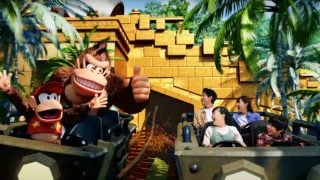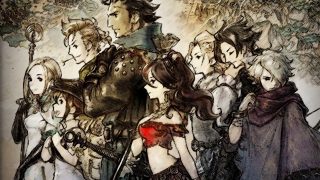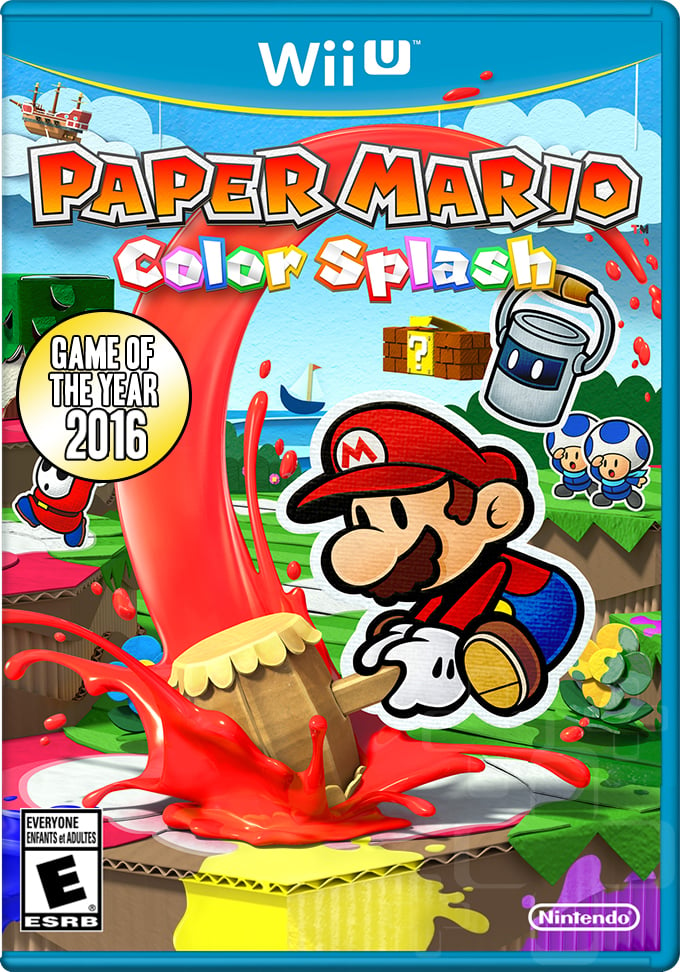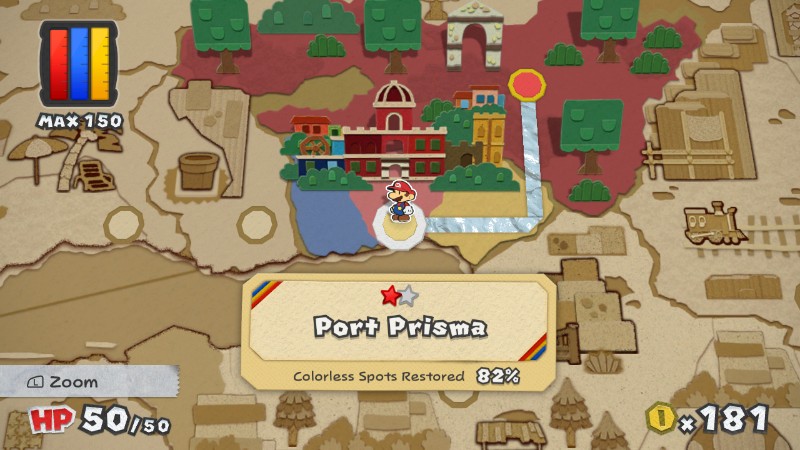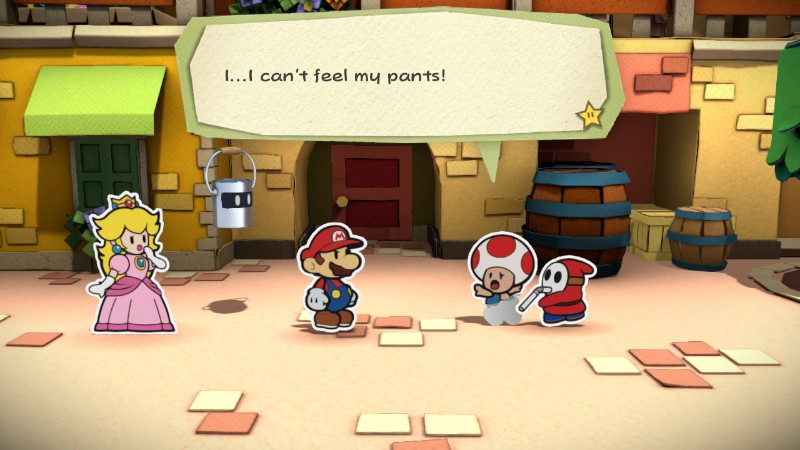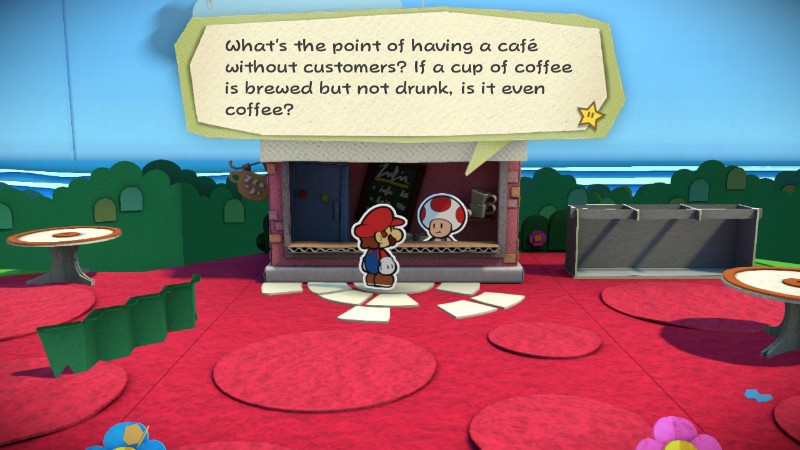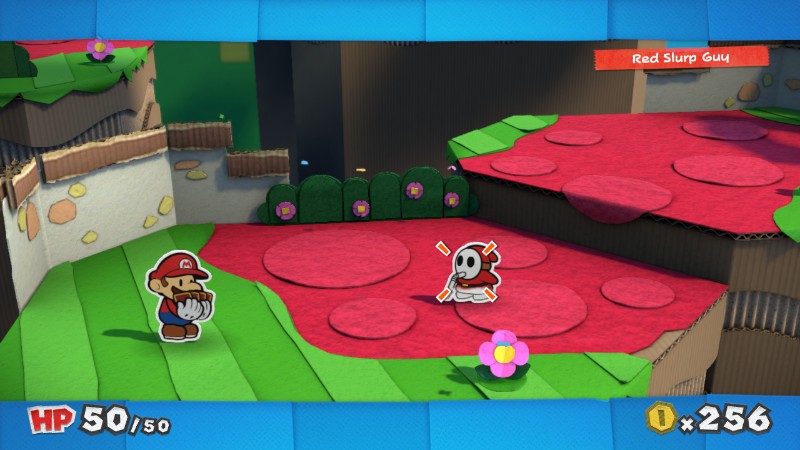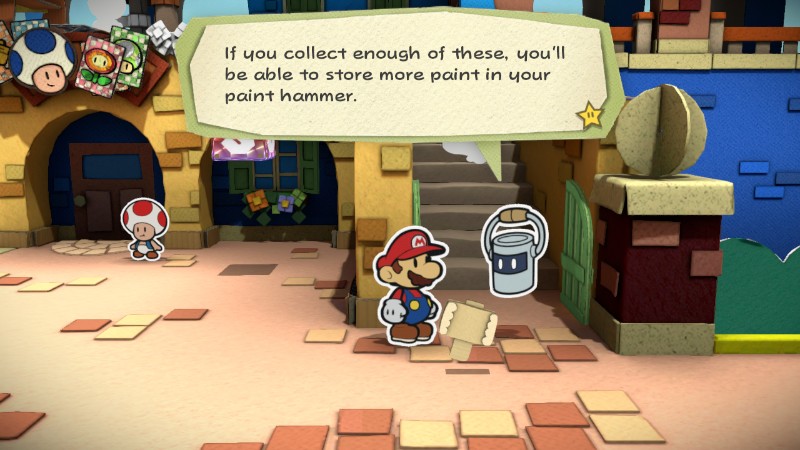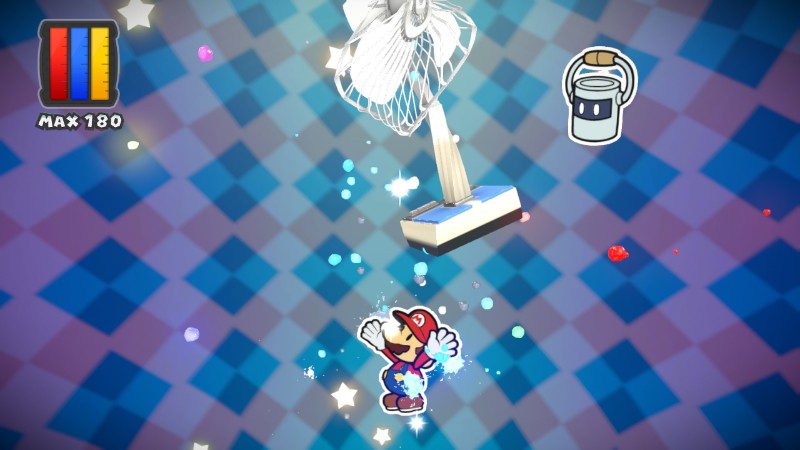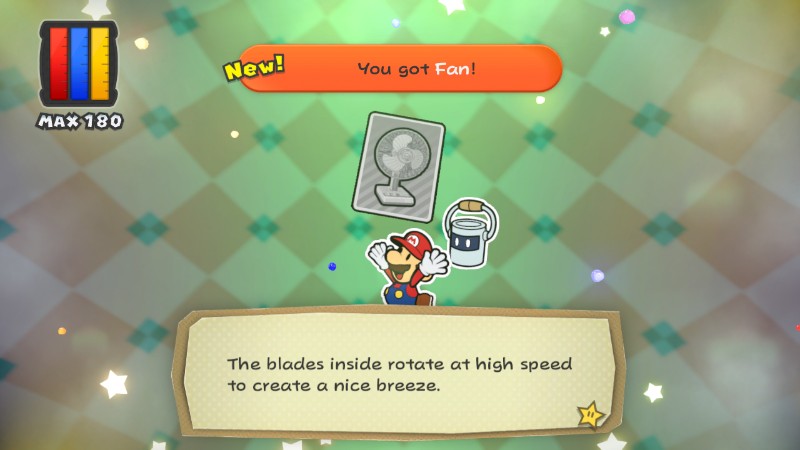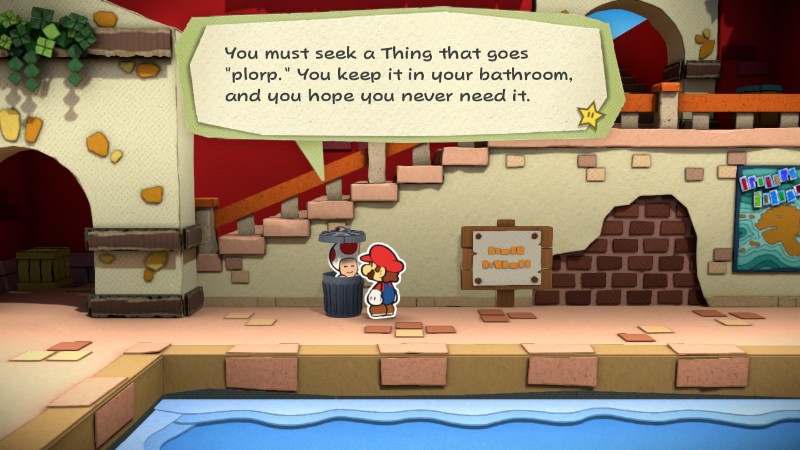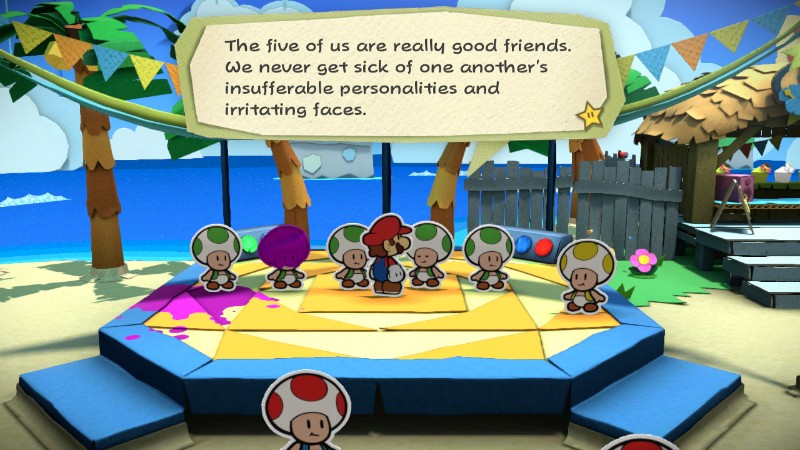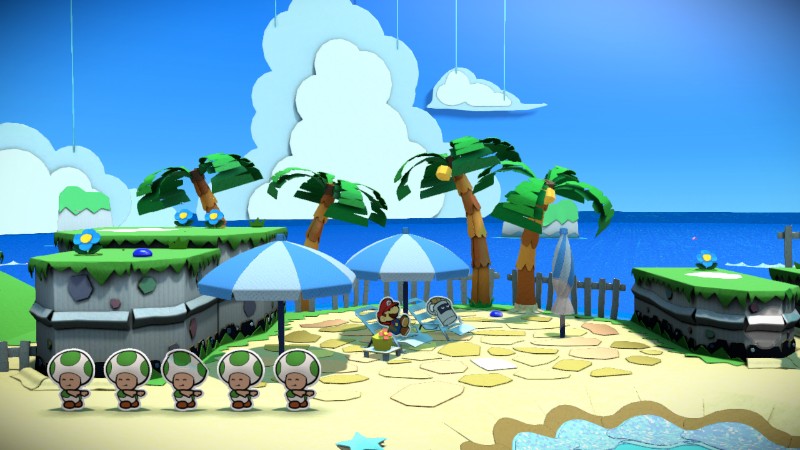Paper Mario first graced the screens of gamers just 15 years ago, spawning a franchise that has spanned nearly every Nintendo console since. In the course of the past decade-and-a-half, the series has taken a turn that has disappointed — to say the least — many fans who adored the games as quirky, colorful RPGs brimming with imaginative characters and locales. The franchise’s direction began to shift with Super Paper Mario, eventually dropping its role-playing elements altogether in 2012’s Paper Mario: Sticker Star. Paper Mario: Color Splash builds off the gameplay introduced in Sticker Star, continuing the series’ existence as a husk of its former self.
Paper Mario has changed for better or, in my opinion, for worse. I am of the mindset that the experiences offered in both Paper Mario and Paper Mario: The Thousand-Year Door were what made the series so memorable — so unique. I was not a fan of Sticker Star: I felt it unnecessarily did away with the series’ most enjoyable features and replaced them with confusing and frustrating mechanics that caused the game to feel more like a chore than anything. Not only that, but it threw out the creativity of past games’ characters in favor of a bland cast of uninteresting Toads and Shy Guys. What happened to the vision? To the magic? Whose call was it to replace the likes of Rawk Hawk and Vivian with the tired and boring allies and enemies we’ve known for the past 30 years?
Will Paper Mario: Color Splash please die hard series fans? No. Is it a contender for Nintendo Wire’s Game of the Year 2016 award? Probably not. (Do we even do that?) Is it a good game in its own right? Oh, yes. Like Paper Mario: The Thousand-Year Door before it, Color Splash has taken its predecessor’s formula and improved on it tenfold. While stripped of the RPG elements both the N64 and GameCube entries were lauded for, Color Splash borrows the gameplay introduced in Paper Mario: Sticker Star and strengthens it in almost every way possible. Though hardcore fans of Paper Mario may still find themselves disappointed, Paper Mario: Color Splash is a robust enough game to stand on its own, making it a worthy member of any Wii U owner’s collection.
Paint with all the colors of the wind
(Or just six.)
Paper Mario: Color Splash starts players off at Port Prisma, a seaside town that was, once upon a time, home to the vibrant Prism Fountain. At the start of the game, the town and the neighboring areas of Prism Island have been drained of color by straw-wielding baddies, forcing Mario and newfound friend and guide Huey to take up the cause of restoring color to the lands. Together, they set off to find each of six Big Paint Stars to return color to the Prism Fountain.
Gameplay echoes Paper Mario: Sticker Star with just a few changes. Gone are the numbered worlds that were present in the last game, which resembled those of main series Super Mario Bros. titles. A World Map is used for navigation, but destinations are a little more diverse than just having simple themes dependent on whichever world they belong to. At the beginning of the game, instead of traversing an entire six-level forest world before fighting a boss, the game has the player explore a typical grassy land, a lake and then a beach for the first three stages. Each land is different, meaning you won’t be stuck in six desert stages in a row. I found this very refreshing, especially when coming off memories of Sticker Star. Each land players visit has one or two end goals (Mini Paint Stars) to seek out while along the way helping the game’s vast collection of multicolored Toads with their silly Toad problems.
In addition to mending the sad and empty fountain in the center of Port Prisma, Mario is also tasked with restoring color to the lands ravished by paintsuckers. He is given a paint hammer, which can splash colored paint (wait a minute… THAT EXPLAINS THE TITLE!) to fill in spots bare and white across the map. Players are rewarded with coins for each successful paint job and each level’s percentage-painted is kept track of on the World Map.
Every level I played was fun, each with its own little quests and platforming challenges. One stage, Bloo Bay Beach, has players take part in a game of hide-and-seek with five Toads, requiring the use of the hammer and some simple problem solving. While there is a massive shortage of original and interesting characters (which we’ll get into later, don’t you worry), there’s no arguing there is plenty of hilarity packed into this game. Countless lines of dialogue had me laughing at their sheer ridiculousness, and there are tons to go around no matter which level you’re playing. While it is a shame many facets of the Paper Mario formula have been laid to rest over the years, I am glad the series’ charm and humor is still strong as ever. The game even gets, dare I say, a bit philosophical at some points, as well…
What is real anymore…? …Ahem.
As the game’s name would imply (still can’t get over that insane realization I had), paint has a megaton role throughout your play. Not only are colorless spot fillings tied to your paint management, but so are battles. Ah, yes, the battle system: one of the more contentious parts of recent Paper Mario titles.
What’s to say about the battle system? In short: it’s alright. It isn’t anything special; it’s fairly bare bones. Players are given red, blue and yellow paint they’re charged with keeping track of. Battle Cards, cards with which you do battle, are scattered throughout levels in ? Blocks, for sale in shops and handed out as prizes for successfully defeating enemies. Each card performs an associated action. The Mushroom card, for example, heals you during battle, while the Jump card allows you to jump on enemies. Certain enemies aren’t affected by certain attacks (Paratroopas with Hammers, for example), so battles do require some level of thinking. For those who’ve played, it’s evident that the system is very similar to Paper Mario: Sticker Star’s.
Each card must be painted before being used (except in the case of already-painted cards, and you’ll find plenty of those), which draws from your red, blue and yellow paint reserves. The colors that are spent are dictated by the color of the card you’re painting. For example, a Hopslipper, which is green, requires blue and yellow paint to color. Your kindergarten education’s really gonna come in handy here.
All card selection and painting is done on the GamePad, which necessitates a few steps to make a move: selecting a card, painting the card (even if it’s already painted) and “flicking” it towards the battle. There’s a setting you can switch on to streamline the process, but by default, it’s somewhat long and annoying. Certain attacks provide the opportunity to hit enemies multiple times by rhythmically tapping “A” while striking foes. Others, like the Hammer, require precise timing in order to hit with full force. Like with Sticker Star, I found myself growing tired of battles pretty quickly. They all play out fairly similarly and don’t offer much in terms of keeping your interest. I’d opt for avoiding battles altogether like I did in Sticker Star if the game’s developers didn’t make one little change…
… Adding incentive! Yes, that’s right: Paper Mario: Color Splash took Sticker Star’s battle system and added an actual reason to participate in battles! Instead of playing through the game, wasting card after card like you’d do with stickers in Sticker Star before realizing you don’t actually have to battle anything other than bosses at all, you’re actually encouraged to battle in order to gain Hammer Points. These little icons can only be collected by felling enemies and allow you to increase the maximum amount of paint you can hold — a necessity, really, as the game progresses.
Why the game makers noticed this glaring flaw in Sticker Star’s gameplay and didn’t instead return to a level-up system, I have no idea. But, hey, it’s better than nothing, right?
Scattered throughout Prism Island, “Things” also return from Sticker Star: realistic-looking objects juxtaposed with the world’s paper-made environment that function as super-powerful attacks. This time, however, they’re transformed into usable card states immediately after being found through a process called “Squeezing.” In addition to be used for attacking, they can also be placed within the world and are, a lot of the time, required to move forward in the game. A Fan, for example, is needed to help a Toad stranded at sea make his way back to shore. Using them in battle is where the real treat lies, though. The cutscenes shown when they’re played are so bizarre and entertaining they’re just about as close as you can get to an out-of-body experience.
A major issue I found with Paper Mario: Sticker Star was its lack of direction. Players would collect Things littered throughout levels and later face a boss that required the use of a very specific Thing. Nothing in the game was made to provide any sort of clue to players what would be needed before facing a boss or some other soft of obstacle. After discovering you were without a necessary Thing (or hadn’t converted it into a Thing sticker), you were forced to backtrack on a wild goose chase to find whatever Thing you’d neglected to grab. Paper Mario: Color Splash remedies this problem, fortunately.
A friendly neighborhood Toad (because, I mean, what else?) that lives in a garbage can provide insights into what Thing players need to progress. In the screenshot above, the Toad is referring to a Plunger, in case your deductive reasoning skills aren’t up to par. Mine are, just in case you hadn’t figured that out, either.
Color Splash really is just the near-perfect version of what Sticker Star set out to be, fixing most of the issues and annoyances of its predecessor. Note that I said “near-perfect” — there are still plenty of factors that caused this could-be-excellent game to just be a great one. Players will find themselves retreading old ground constantly by revisiting past stages in order to collect all their Mini Paint Stars and unlock new paths. Level design is also extremely linear and heavy on battles until later in the game, when problem solving takes the reins. New mechanics are also a bit of a letdown, from the cut-out tool to “Unfurl” blocks (hit a specially marked block and then run against a timer to a specially marked item, like a pipe, to “unfurl” it), both of which just add convolution to what are still very straightforward levels.
A plot as tired as Toads
As far as story goes, you won’t find anything captivating here, but I suppose that’s to be expected considering the series’ move from RPG to action-adventure. I won’t spoil it, but you’ve pretty much seen this game’s narrative played out a billion times before in past Mario games. Character-wise, the gang’s all here: Mario, Peach, Luigi, Bowser, the Koopalings and all the misfits from King Koopa’s army. Oh, and Toads. Lots and lots of Toads.
There are a few original characters. You have Huey, of course: your guide who’s a levitating paint bucket. There’s the Rock Paper Wizard, a seasoned vet in the cutthroat world of competitive roshambo-ing who’s also just a Toad in a funny hat. There are the members of the Toad Rescue Squad, who are simply Toads with special color schemes. There’s also Toad with Sunglasses. Oh, and the Toad with goggles who runs the Port Prisma museum. Love that guy.
Nearly every NPC you run into during the course of Paper Mario: Color Splash is a Toad. Occasionally, you’ll run into a Shy Guy or some other common Mario enemy, but most of the time, you’ll be dealing with Toads. I can’t say I’m particularly fond of this. Actually, y’know, I’ll just come right out and say that I hate the lack of characterization in recent Paper Mario titles — it’s a problem that even carried over to recent crossover Mario & Luigi: Paper Jam. The Paper Mario series was at one time rich with unique, original characters with defining personalities. In Color Splash, the best you’ll get in the realm of characterization is finding a Toad who’s slightly more quippy than another.
There are only so many times I can watch the same, exact story play out with just a few tweaked details in a Mario game. There are only so many times I can bear interacting exclusively with Toads whose only differentiators are the colors of their hats. So much potential was wasted both story-wise and character-wise in Color Splash, which I feel negatively impacted the overall character of the game. The Paper Mario universe is so fun and zany — it’s a shame to see that Toads will be its only occupants for the foreseeable future.
A stroke of beauty
Paper Mario: Color Splash’s saving grace personality-wise is its art and sound design, both of which are spectacular. The game is gorgeous, there’s no denying that, and the effort taken by developers when crafting Prism Island is definitely apparent. Every inch of the game world is dripping in color and detail, and often I’d find myself impressed at the ingenuity of the artists — a reaction I’d compare with mine to the comparatively-stunning Yoshi’s Woolly World. Everything is vibrant and pops from the screen, with the differing “materials” used for in-world objects almost convincing enough to make you believe you’re playing in an actual diorama.
Music is extremely varied given the diverse themes of Prism Island’s levels, with the tropical tunes of Bloo Bay Beach, the soothing flute melodies of Cherry Lake and the occasional re-imaginings of tracks from past Mario games. There is no doubt in my mind the amount of love and creative energy that went into building the world and soundtrack of Prism Island. There’s a certain flair to Paper Mario: Color Splash that’s hard to find elsewhere, and the art and sound directors are to thank for that.
Despite its faults, Paper Mario: Color Splash is a solid title that deserves a place on your shelf (or hard drive). It isn’t the Paper Mario game fans have been craving, but it’s worthy of any gamer’s time and money, combining fun gameplay with top-notch graphics and music and that so-uniquely-Paper Mario sense of humor. Now, if you’ll excuse me, I have a game to finish. Right after I get my bronze on at Bloo Bay Beach, of course…
Leave a Comment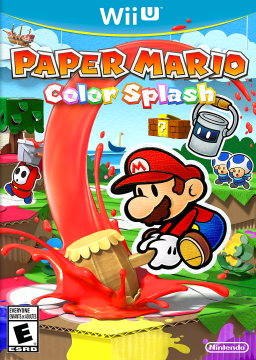
System: Wii U
Release date: October 7, 2016
Categories: Action-Adventure
Publisher: Nintendo
Developer: Intelligent Systems
